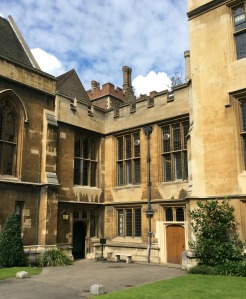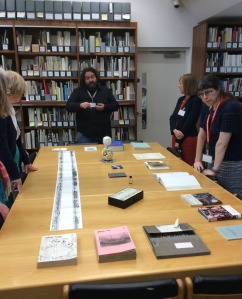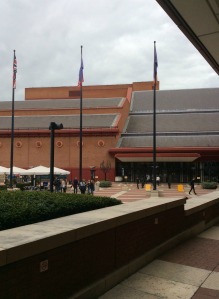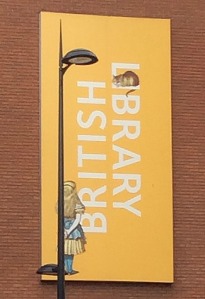Last September (2-4 Sept) I was pleased to be able to attend the CILIP Rare Books & Special Collections Group conference in London. I had intended to blog about this straight away, but was struck down with appendicitis the following week, and have only now got the time to do so.
I had been invited to speak about the Cardiff Rare Books Collection, housed in SCOLAR and acquired from the Public Library in 2010. The theme of the conference was “Hidden collections revealed” and this covered topics from retrospective cataloguing, to private libraries, and embargoed collections to active promotion. The conference took place over three days and in three different venues – Friend’s House, Lambeth Palace, and the British Library. This allowed attendees the opportunity to have tours of the libraries in these places, although as places were limited not everyone got to see everywhere (myself included).
The first day began with an overview from Karen Attar (Senate House Library) on the (then forthcoming) Directory of rare books and special collections in the UK and Republic of Ireland. This is the third edition of the directory, previous editions appeared in 1985 and 1997. Attar is the editor and initially emailed potential contributors in 2014 asking for updates to their previous entries, or for new entries if they had not appeared before. The team in SCOLAR were able to compile an extensive update to the Cardiff entry to reflect all the changes and acquisitions we have had since 1997. Overall the book will be important to make people aware of different collections across the UK.
Following on from this David Prosser (RLUK) talked about the survey of hidden collections that took place in 2010. There were 77 respondents to the survey, it seemed that smaller libraries didn’t have the time or the manpower to respond. The survey also revealed that there were degrees of hidden, some were uncatalogued, some had card catalogues or printed catalogues. Modern problems of digitised materials were also highlighted. How long will these be available on line? Apparently 20% has already been lost to the web, creating a 21st century black hole of material.
The second session of the day focussed on uncatalogued material, and a variety of projects designed to combat this problem. Dunia Garcia-Ontiveros (The London Library) discussed a project they had been running from 1999, which had been revitalised when she took up her position there in 2007 and ensured that records were upgraded with material in hand. Previously they had just been importing records to improve what they had, since 2007 they have been able to add local detail such as provenance, bookplates, annotations etc. The project has highlighted the significance of not only what they knew they had, but all the extras associated with it.
Next, Darryl Green (St. Andrews) talked about the Lighting the Past project at St. Andrews. The initial stages of the project revealed that only 25% of their special collections were catalogued, as opposed to the 50% they had previously thought. Quantifying this to the institution meant that there were 150,000 uncatalogued rare books, and at their former rate of cataloguing this would have taken them 75 years to complete. They looked at a variety of ways to deal with this problem and this resulted in Lighting the Past. Student workers have been employed for the first phase of the project – giving them employment and training in specialist skills. The second phase will involve Rare books cataloguers upgrading records to full DCRM(B) standards.
Another project in Scotland was discussed by Elizabeth Quarmby Lawrence (Edinburgh University), they had difference circumstances to St. Andrews, and their approach was to have two paid internships, for two days a week for nine months (Feb-Oct 2014) – this offered opportunity and experience for the individuals. Training started with easier material and progressed onto more difficult material. The internships were a rounded experience, and included working on blogs, events, student liaison, and exhibitions. The training scheme was a great success, and one of the interns has now been employed in the rare books cataloguing department.
 The second day of the conference was at Lambeth Palace (where our former colleague Ken Gibb now works). The third conference session was about being open for research and had sessions from libraries that are not necessarily open to the public. Martin Cherry (Freemason’s Library) talked about the history, and the use and access to the Library and Museum of Freemasonry which was first established in 1837 by the Grand Lodge. Originally access was restricted to Freemasons but is now open to all.
The second day of the conference was at Lambeth Palace (where our former colleague Ken Gibb now works). The third conference session was about being open for research and had sessions from libraries that are not necessarily open to the public. Martin Cherry (Freemason’s Library) talked about the history, and the use and access to the Library and Museum of Freemasonry which was first established in 1837 by the Grand Lodge. Originally access was restricted to Freemasons but is now open to all.
Next we heard about military libraries from John Pearce (Deputy Librarian, The Royal Military Academy Sandhurst). Defence libraries are not regimental museums, they deal with material on the MOD, technical material etc. So why are there rare books in defence libraries? These are historical training manuals, and operational requirements, acquired for specific purposes at the time of publication – and now useful for the history of military education. With these libraries there is a restriction to access, as they are ‘behind the wire’ – but they do have a web presence to a certain extent, and they are beginning to digitise some material at Sandhurst.
To close this session we then heard about the Association of Pal Mall Libraries from Kay Walters (The Athenaeum), Sian Prosser (Royal Astronomical Society), and Renae Satterley (Middle Temple Library). The Association of Pall Mall Libraries was set up so that solo librarians could get to share knowledge and resources. The libraries range from private members clubs to societies, and the library collections range in size from 2K – 100K; some are research resources, some historical assets. There is a mixture of qualified and nonqualified staff running the libraries.
The final session of this day looked at collections that were ‘under wraps’ and included my own paper Collating and curating for the public: the Cardiff rare books collection which demonstrated the change in priorities at the Public Library, which went from actively acquiring rare and manuscript materials at the beginning of the 20th century for the public to use, to ‘hiding’ them away in stores and discarding them by the start of the 21st century.
In this session Helen Potter (FOI Centre, National Archives) discussed closed records at The National Archives, and issues surrounding the right to know vs right to privacy. There are a number of reasons why records might be closed, which might be to do with specific individuals (personal case files, e.g. prisoner files, naturalisation 1938-1945, criminal prosecution). Or the files might be closed because they are distressing and disturbing (rape, assault, mental distress). They are currently operating on the following principle – ‘release what we can, protect what we must’.
 After lunch, there were guided tours of Lambeth Palace library, and then the rest of the afternoon was devoted to a variety of visits to special collections within London. Participants could sign up to two visits, and there was a bit of tube co-ordination required! I chose two places that were next to one another, and coincidentally not that far from Lambeth Palace either! My first visit was to the Print Rooms at Tate Britain; we were shown prints by a variety of artists, and some of Turner’s sketch books. We also got to see Beatrix Potter’s drawings for The Tailor of Gloucester. My second visit was to Chelsea College of Arts to see their Artists’ books collection – it was interesting to compare their collection with the one at Cardiff Metropolitan University that I had visited earlier in the year.
After lunch, there were guided tours of Lambeth Palace library, and then the rest of the afternoon was devoted to a variety of visits to special collections within London. Participants could sign up to two visits, and there was a bit of tube co-ordination required! I chose two places that were next to one another, and coincidentally not that far from Lambeth Palace either! My first visit was to the Print Rooms at Tate Britain; we were shown prints by a variety of artists, and some of Turner’s sketch books. We also got to see Beatrix Potter’s drawings for The Tailor of Gloucester. My second visit was to Chelsea College of Arts to see their Artists’ books collection – it was interesting to compare their collection with the one at Cardiff Metropolitan University that I had visited earlier in the year.
The final day took place at the British Library Conference Centre, and the first session looked at promoting collections. Adrian Edwards (Head of Printed Heritage Collections, British Library) talked about the potential of exhibitions to bring hidden collections into the lime-light, and focussed on a specific example of the ‘Comics unmasked’ exhibition which was held in 2014.
 He highlighted that the objective of exhibitions are wider than what you see in the gallery. For example with this collection initially the material was spread over different sites and wasn’t catalogued consistently, if at all. However, due to the exhibition many comics got catalogued – the power of the exhibition gave leverage to the cataloguing priorities. They were able to convince the data quality team to see the cataloguing of the comics as a training opportunity – serials, complexities etc. Now all the material is available on one site, is used more, and the rare material has been moved to higher level of secured storage. In addition staff expertise has improved; some have given papers at academic conferences.
He highlighted that the objective of exhibitions are wider than what you see in the gallery. For example with this collection initially the material was spread over different sites and wasn’t catalogued consistently, if at all. However, due to the exhibition many comics got catalogued – the power of the exhibition gave leverage to the cataloguing priorities. They were able to convince the data quality team to see the cataloguing of the comics as a training opportunity – serials, complexities etc. Now all the material is available on one site, is used more, and the rare material has been moved to higher level of secured storage. In addition staff expertise has improved; some have given papers at academic conferences.
Next was Lara Haggerty (Innerpeffray Library). Innerpeffray library is five miles from the nearest town, and a bus only comes once a week, the library is essentially in the middle of nowhere. It was the first free public lending library in Scotland, set up in 1680. Originally in the loft of the chapel it started with 400 books. In 1968 they stopped lending books, there was a decline after the First World War, and there were other libraries in nearby towns, and the library began to disappear from people’s awareness.
By 2001 things were not looking too good: “We can no longer open the door and hope”
In 2009 Lara Haggerty was appointed as Library keeper and marketing manager, the 31st library keeper there has been. She created a business plan to raise visitors by 100% – quite a challenge! She highlighted that they were selling something different, a unique experience for the visitor. As part of this they have partnered up with local businesses, and they now hold events, like gin tasting in the library (!), and “How far would you walk for a book” walk, etc.
The final talk of this session was by Katie Sambrook (Kings College London) who talked about the Foreign and Commonwealth Office library collection at King’s College London. There are 100,000 items in the Foreign & Commonwealth Office library collection, mainly books, but manuscripts as well, covering 16th-21st centuries, with the heart of the collection from 1750-1950. There were difficulties for the library when it was situated in the Foreign and Commonwealth Office, with security, couldn’t bring in lap tops, etc, so it was transferred to an appropriate academic institution. They have needed to catalogue all items from scratch, book in hand, and have about half done at the moment. They think that the catalogue is the best way of advertising the books, but have also promoted the collection by an exhibition space and online. They have used targeted promotion, picking a country or area, and found that even just a poster on library gates brought people in.
The last three talks were in a session that looked at going ‘beyond the library’, firstly Katharine Hogg (Foundling Museum) talked about the Gerald Coke Handel Collection at the Foundling Museum. Gerald Coke was a banker and in the 1930s started to collect Handel material – he chose Handel because he was first published in England and at available prices (Mozart was too expensive!). He was a generous collector and let scholars use the material even though he kept it at home, and he did have a house catalogue. The collection came to the Museum with an endowment, and although not quite a lending collection now, a database of the collection is now online.
Hannah Manktelow, a PhD student, talked about her research discovering provincial Shakespeare with the British Library Playbill collection. The collection contains playbills from the provinces as well as London, and much of what we know about theatrical history comes from playbills – when/where/who/what. The bulk of playbills date from 1780-1880. As there are 75,000 provincial playbills, to manage the project she picked five provincial towns – Newcastle, Nottingham, Norwich, Bath and Brighton. She decided to focuss on England for a national representation. She has been looking at where Shakespeare was performed (theatres, portable venues, etc); Who performed (a resident company, London stars, touring company. Bath received double the amount of stars than Newcastle – closer to London and very fashionable); and also when – what percent of the theatrical season.
One discovery has been that regional Shakespeare was more avant-garde, and had the first black perfo rmer in Othello, he was very famous, but not accepted to play in London until the end of his career.
rmer in Othello, he was very famous, but not accepted to play in London until the end of his career.
The final talk of the session and the conference was by Mark Byford, a private collector of rare books. He has been a collector for 12-15 years, and has a focus on Tudor and Jacobean books, but not a limit on subjects. There are about 1000 books in his collection. There is no catalogue of his collection, but he does allow people to visit to look at, or to take out, books. Access is dependent on collector/owner, personal contacts, but Byford believes he knows his books better than a librarian would (possibly).
Overall the conference was fascinating, lots of wonderful collections were talked about and we got to visit some great venues, and see some collections we wouldn’t necessarily get the chance to. The only downside for me was that because the conference was spread over three venues there was no central ‘conference venue’ or accommodation. As a non-Londoner there was a bit of stress in trying to work out a) where to stay, and b) how to get to each venue each day. In addition there was no one place where all attendees were together outside of scheduled events (i.e. no conversations at breakfast, or hanging around the bar together at the end of the evening event). But it was an interesting way of holding a conference, and I managed not to get lost more than once!















